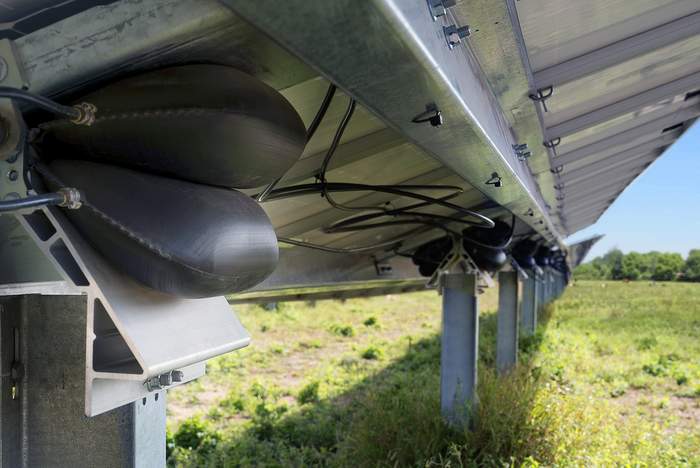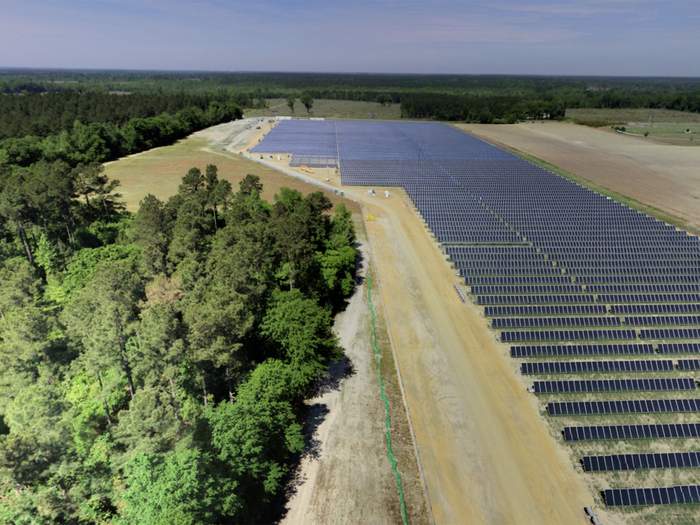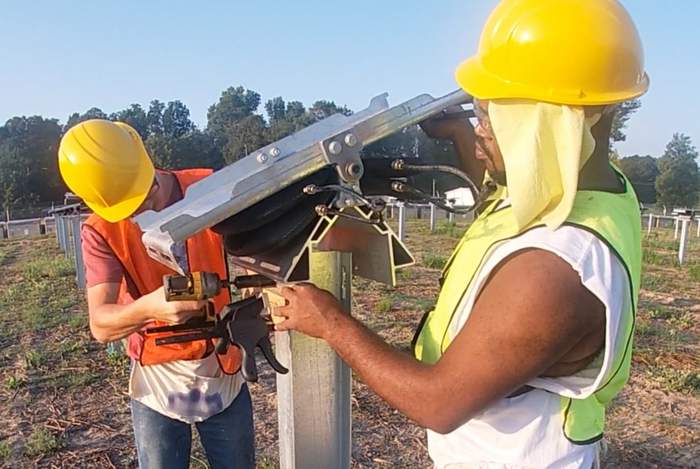New systems with “innovative concepts” can be a challenging decision for solar developers and EPCs, and rightfully so when it comes to solar trackers. But what if that innovation is based on one of the oldest, most reliable power-conversion concepts humankind has, fueled by our most plentiful free resource? That is the proposition of Sunfolding’s totally unique T29 solar tracker, which is powered by air pneumatics, and results in a tracker that involves fewer structural components, electronics and maintenance points than any other on the market.
A new system built on an old idea is an allegory for the company itself. Sunfolding has a foothold in the segment with 26 projects in the ground across eight states, currently. Helmed by a deep roster of utility-scale solar industry veterans formerly of First Solar, SMA and Schletter, and a Series B funding round of $32 million with backing from G2VP and Macquarie Capital, the company is ramping up its capacity with more equipment, manpower and QA/QC.
Sunfolding’s average project size is in the 10 to 40 MW range right now, having successfully moved through test projects with the support of California Energy Commission and U.S. Department of Energy (DOE) funding to de-risk and prep the technology for scale. About half of their 26 completed projects would qualify as utility-scale, and RFPs are now rolling in to serve the 100+ MW range.
Let’s take a closer look at how all of these design changes impact installation, project timelines and bottom lines.
Holy Moly
That’s what I said when checking out some projected project cost savings on background. Since I can’t print them, just consider what a 40 to 70 percent reduction to earthwork costs could do for your next project.
“We had an inkling, but we have surprised ourselves with this, in a good way,” says Gwen Rose, VP of marketing for Sunfolding.
Sunfolding’s T29 single-axis tracker consists of the only three structural components: purlin, actuator and post. They are secured with two bolt sizes and one torque spec. The company eschews the torque tube for a harness that unspools and emphatically snaps into place.
“Our actuator is doing what the motors, bearings and gearboxes are all supposed to do in other systems,” Rose says.
Some specs to note:
● Reset plane of tracker after only 90 feet (1-string)
● 12.3% slope tolerance (North – South) standard
● No structural connections (East – West) or (North – South).
● Shorter post embedment depth, which means fewer pile rejections
Sunfolding is shooting to serve (and is serving) huge utility-scale projects, but it’s gaining momentum on sites with challenging parcel boundaries and extreme terrain conditions.
“We’re seeing more and more projects with high sloped terrain or other parcel constraints,” Rose notes. “Because our architecture is so distributed, we can do shorter row lengths. This means we can really tackle terrain limitations in a way that would normally come with a premium from another tracker.”
Why pneumatics? And why Sunfolding?
When the tracker market started taking off on its current conceptual trajectory, Sunfolding, founded in 2012, started tinkering with new actuation concepts thanks to a grant from ARPA-E and the DOE. Pneumatics immediately stood out — a $5.3 billion industry built on a 360-year-old method for converting power to production.
“Asking machines to slowly tilt once per day for 30 years is not a big lift,” Rose says, “but you need to know what the right materials are, what the right manufacturing process is, you need to develop an actuator that doesn’t have sliding seals, which is the common failure point in a pneumatic system. And you need the ability to move what was normally done with hardware into software.”
The patented AirDrive technology invented by CTO/Founder Leila Madrone checks all of those boxes. Each AirDrive unit consists of flexible bladders enclosed in a rugged metal housing with a bladder to the east and one to the west. When the bladders are pressurized to different levels, one side expands, tilting the solar module structure above to the opposite direction. The control of the air pressure in the bladder works to track the structure towards the sun.
The components of the AirDrive are equally, well, air tight. It is made from polymers selected in cooperation with Dupont that have proven successful in marine tethers, cushioning used in railroad transportation, and protective material in the auto industry used for the joints that connect vehicle transmission to the wheels. The tubing and connectors that link controllers and actuators come from the air brakes and fuel lines used in commercial motor vehicles, both subject to auto industry standards.
Cascade of efficiencies
The AirDrive led to a simpler tracker structure, and simplicity means speed. A third-party study from Eclipse-M clocked Sunfolding at “the lowest man-hour per megawatt factor that we have measured,” notes Bill Poulin, managing partner, Eclipse-M.
“You get this repeatable cadence throughout the field and you can get people up to speed faster, with fewer chances for error,” Rose says. “Crews are operating in tough conditions and have varying levels of experience and training, so you want as little decision-making in the field as possible.”
Plus, fewer parts, especially unique parts, increases efficiency across the board, from material distribution to installation time, to project QA/QC. There’s the potential for big time Opex savings here. We’re accumulating the field data to prove this out over 350 million accumulated operating hours at presstime), but think about it: There are no bearings to grease, there are no batteries involved, there are hardly any moving parts. The only maintenance item is an air filter in the compressor that needs to be changed out annually, reducing maintenance locations by up to 95 percent.
“We’re building an actuator with a design lifetime that’s much longer than that of even the panels. So we feel we have a lot of ownership advantages,” Rose says. “One way to think about our system is it’s like having really nice suspension in a car. It fundamentally responds differently in wind than an electromechanical tracker with a torque tube.”
This fundamentally different structure also may be less of a risk in typical tracker-failure events, plus the pneumatic system has far fewer critical points of failure. Still, things happen. As Gwen politely puts it, “people find creative ways of doing things.” To help ensure customers see the construction savings possible, Sunfolding is building out its Construction Network, which is taking on more of the installations. The company also has an abundance of how-to videos and white papers that further explain everything.
“We know it’s a very different way of doing things, so we have a lot of education on what a pneumatic system looks like and why it’s more durable and reliable,” Rose says.
For more on the science of pneumatics and how it led to everything I’ve discussed here, definitely check out Sunfolding’s recent white paper here.
— Solar Builder magazine




Leave a Reply
You must be logged in to post a comment.